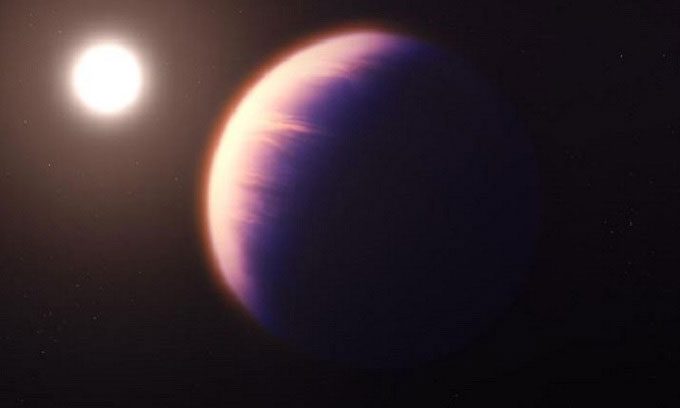The first direct evidence of the existence of CO2 in the atmosphere of the exoplanet WASP-39b has been recorded by the James Webb Space Telescope.
The exoplanet WASP-39b is a massive hot gas giant orbiting a star located 700 light-years away from Earth. Along with two other exoplanets, WASP-39b is a research target for the James Webb Telescope. Understanding the atmospheric composition of planets like WASP-39b is crucial for uncovering their origins and evolutionary processes, according to a NASA announcement on August 25.

The exoplanet WASP-39b takes 4 days to orbit its host star. (Photo: NASA)
“The CO2 molecule is a compound that marks the history of planet formation,” said Mike Line, an assistant professor at the School of Earth and Space Exploration at Arizona State University. Line is a member of the JWST Transiting Exoplanet Community Early Release Science team conducting the research.
The research team utilized the Near Infrared Spectrograph, one of the four scientific instruments aboard the James Webb Telescope, to observe the atmosphere of WASP-39b. Their study is part of the Early Release Science program, an initiative designed to provide data from the telescope to the exoplanet research community as quickly as possible. The latest findings have been accepted for publication in the journal Nature.
“By measuring CO2, we can determine the ratio of solid and gaseous materials that formed this giant gas planet,” Line noted. “In the coming decade, JWST will conduct this measurement across many planets, providing detailed data on the planet formation process and the uniqueness of our Solar System.”
The James Webb Space Telescope, which has high sensitivity, was launched on December 25, 2021, to its current orbit 1.5 million kilometers from Earth. By observing the universe with longer wavelengths of light than any other telescope, Webb can study the first galaxies that appeared, looking deep into clouds of dust where stars and planetary systems are forming. In the spectrum of WASP-39b’s atmosphere, researchers found a peak around 4.1 – 4.6 microns, a clear sign of CO2, according to team leader Natalie Batalha, a professor of astronomy and astrophysics at the University of California, Santa Cruz. (One micron is one-millionth of a meter.)
Depending on the composition, thickness, and coverage of clouds, the atmosphere absorbs certain colors of light more than others, making the planet appear larger, according to Munazza Alam, a postdoctoral researcher at the Earth and Planets Laboratory at the Carnegie Institution. Since each gas absorbs a different combination of colors, researchers can examine slight differences in brightness across a wavelength spectrum to accurately determine the compounds that make up the atmosphere. Previously, NASA’s Hubble and Spitzer telescopes had detected water vapor, sodium, and potassium in the atmospheres of exoplanets.
Discovered in 2011, WASP-39b has a mass comparable to Saturn and is one-quarter that of Jupiter, while its diameter is 1.3 times that of Jupiter. Because this exoplanet orbits very close to its host star, it completes an orbit in just over 4 Earth days.

















































